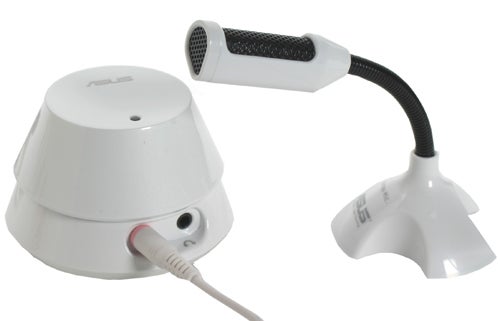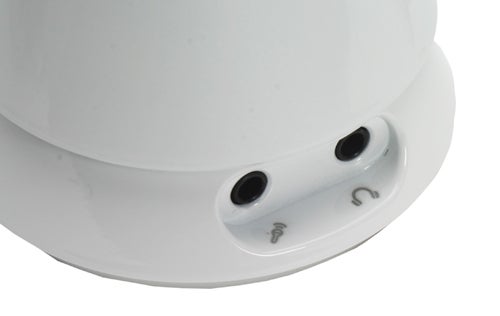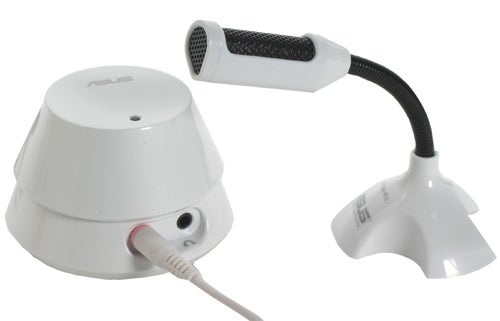ASUS Xonar U1 USB Audio Station Review
ASUS Xonar U1 USB Audio Station
We were big fans of the internal version of this sound card. Can Asus do the double with the external model?

Verdict
Key Specifications
- Review Price: £53.30
The Asus Xonar D2 was widely considered to be a successful entry into the sound card market for Asus, offering a powerful multi-purpose card designed to appeal to both gamers and budget music production. Following on from this debut, Asus has released its first USB audio device, the Xonar U1.
The U1 has a distinctive round metal knob design far removed from the typical black plastic box. Not only is it visually appealing, but it looks solid and manages not to feel like a budget device.
The top half acts as a volume dial providing a pleasingly tactile way of controlling the sound. Pressing down mutes or un-mutes the audio. There are only two audio connections, both mini-jacks. One acts as a line in or microphone input (selectable in the software mixer), the other is an analogue stereo output intended to be used by headphones or speakers and doubles as an optical out for Dolby Digital (& Live) and DTS. 
Whilst the unit itself is a comfortable size, the USB cable is very short, which could be an issue if being used with a desktop computer or laptop with little desk space. The cable is directly attached to the device so at least it’s not something that can be forgotten if it’s to go travelling with you. Also somewhat uncomfortably small is the recess for the headphone and line jacks. My Grado 60 headphone cable just about squeezed in but not my jack to phono lead which proved too chunky.
In terms of functionality, the device offers a similar set of abilities to its PCI counterpart, but with only the two audio connections it is considerably less flexible. So once again you get a flurry of ®s including Dolby Headphone, Dolby Virtual Speaker, Dolby Pro Logic IIx, Dolby Digital Live, Xear 3D Virtual Speaker Shifter, etc. I’ve written before how I’m not a fan of processing sound to make it appear as surround on headphones or two speakers. All of these technologies rely on altering the phase of the audio signal, which interferes with the precision and clarity of the stereo mix and tends to add phasing artefacts.
As the U1 has only a digital out, the benefits of discrete surround sound will only be available if you optically connect the U1 to a surround decoder box. Presumably this is a cost issue but I would have thought including surround analogue outputs onboard, or via a breakout cable like many of Creative’s offerings, would have made it a more attractive option, particularly for home theatre users. However, if your amp does have a decoder then Dolby Digital Live will let you enjoy games in surround sound without the need for a spaghetti junction of wires.
What impressed me the most about the D2 though was the quality of the highly regarded audio converters. Throwing a dizzying array of features and a generous software package in is appreciated but if the sound isn’t up to scratch, it’s all somewhat redundant. It’s unclear what converters the U1 uses since the only labelled audio chip inside has Asus’ own name on it.
Having the audio converters outside of the electrical maelstrom present inside most laptops will in itself often result in a far cleaner sound with less interference. Comparing the playing of music with my Emu 1616 PCMCIA card does reveal quite a difference, as would be expected. The Xonar’s headphone output is reassuringly noise free but the audio playback quality, while acceptable for a budget sound card, noticeably lacks the sharpness and accuracy of the Emu.
Including a microphone in the box is a useful addition if you wish to use a VoIP application. Like the main unit it looks pretty but sounds cheap and rather thin, even when placed close to the sound source (i.e. your mouth). Enabling the array microphone option in the software mixer does remove much of the background noise present but results in an even more flimsy sound. If VoIP is the main motivation for looking at buying the U1, you may well be better with a headset.
In Ubuntu 7.10, basic playback and recording worked although the software mixer behaved unreliably, initially only playing back sound from one speaker and you’ll obviously get none of the effects or surround capabilities.
No dice on Mac support though. Just prior to writing this review, I noticed that the Asus website had OSX drivers listed but clearly this is just a tease – trying to download from the site leads to a 404. Should Mac drivers appear, depending on whether the full functionality of the card is available, it could find a very comfortable niche in the more poorly served OSX market. Otherwise the U1 is an attractively designed package with a good range of features but lacks the kind of excitement generated by the D2.
”’Verdict”’
While it looks and sounds reasonable, there’s no real stand-out feature on the Asus Xonar U1 USB AudioStation. The USB audio card market is already well served, and quick search on eBuyer shows a USB card for just £11 that has many of the same features.
Trusted Score
Score in detail
-
Value 7
-
Features 7

